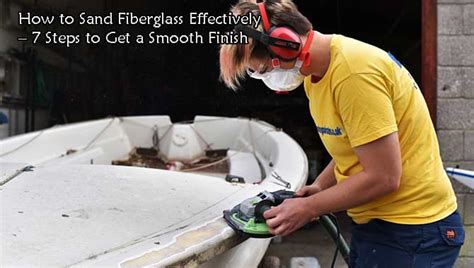How To Sand Fiberglass
Ronan Farrow
Mar 26, 2025 · 3 min read

Table of Contents
How to Sand Fiberglass: A Comprehensive Guide
Sanding fiberglass is a crucial step in achieving a smooth, professional finish on your project. Whether you're repairing a boat, restoring a car part, or creating a custom fiberglass creation, proper sanding techniques are essential for success. This comprehensive guide will walk you through the process, from choosing the right tools to achieving a flawless finish.
Choosing the Right Sandpaper and Tools
The key to successful fiberglass sanding lies in selecting the appropriate sandpaper and tools. Different grits of sandpaper are needed for various stages of the sanding process.
Grit Selection: A Step-by-Step Approach
- Coarse Grit (20-40 grit): Use this grit for initial shaping and removing large imperfections or excess resin. Be mindful not to remove too much material at this stage.
- Medium Grit (60-100 grit): This is used to level out the surface after coarse sanding, smoothing out the scratches left by the coarser grit.
- Fine Grit (150-220 grit): This stage refines the surface, removing finer scratches and preparing it for the final sanding.
- Very Fine Grit (320-400 grit): This is your finishing grit, leaving a super-smooth surface ready for primer or paint. This is crucial for a professional-looking finish.
Pro Tip: Always use a fresh piece of sandpaper for each grit. A clogged sandpaper will only scratch the surface, negating your efforts.
Essential Tools for Fiberglass Sanding
- Sandpaper: As mentioned, various grits are necessary. Consider buying sandpaper in sheets for flexibility and cost-effectiveness.
- Sanding Block: A sanding block provides a consistent, even pressure across the surface, preventing uneven sanding and swirl marks.
- Random Orbital Sander: This power tool significantly speeds up the sanding process, especially on larger surfaces. However, use caution not to remove too much material too quickly.
- Dust Mask: Fiberglass dust is harmful to your lungs. Always wear a respirator mask designed for dust particles.
- Safety Glasses: Protect your eyes from flying debris.
- Gloves: Protect your hands from irritation.
The Sanding Process: A Step-by-Step Guide
This process should be followed methodically and patiently to achieve the best results.
Step 1: Preparation
Begin by thoroughly cleaning the fiberglass surface. Remove any loose debris, dust, or contaminants. A clean surface will prevent scratches and ensure even sanding.
Step 2: Coarse Sanding
Start with the coarsest grit sandpaper (20-40 grit). Use a sanding block or random orbital sander, applying even pressure. Focus on removing any large imperfections or unevenness. Remember, you can always remove more material but you can’t put it back!
Step 3: Medium Sanding
Once the coarse sanding is complete, move to the medium grit (60-100 grit). This stage refines the surface, smoothing out the scratches left by the coarser grit. Sand in a consistent direction, overlapping your strokes to ensure even coverage.
Step 4: Fine Sanding
Continue the process with the fine grit sandpaper (150-220 grit). This step removes any remaining imperfections and prepares the surface for the final sanding. Maintain consistent pressure and overlap your strokes.
Step 5: Very Fine Sanding
The final sanding stage uses the very fine grit sandpaper (320-400 grit). This will create an ultra-smooth surface, ready for primer or paint. Sand lightly and carefully in this stage to avoid removing too much material.
Step 6: Cleaning
After sanding, thoroughly clean the surface to remove all dust particles. A tack cloth is excellent for this purpose.
Tips for Success
- Sand in one direction: For best results, sand in one direction with each grit. Change directions for each grit.
- Work in small sections: Avoid sanding over large areas at once. Concentrate on smaller sections to maintain even pressure and prevent uneven sanding.
- Regularly inspect your work: Check your progress frequently to ensure you are achieving the desired smoothness.
- Use proper ventilation: Fiberglass dust is harmful, so make sure you're working in a well-ventilated area.
By following these steps and tips, you can achieve a perfectly smooth and professional finish on your fiberglass project. Remember, patience and precision are key to success. Happy sanding!
Featured Posts
Also read the following articles
| Article Title | Date |
|---|---|
| How To Unfreeze Pipes In Mobile Home | Mar 26, 2025 |
| How To Roost A Turkey In The Evening | Mar 26, 2025 |
| How To Send Anonymous Flowers | Mar 26, 2025 |
| 1500 Howa 308 Review | Mar 26, 2025 |
| How To Soften Cotton | Mar 26, 2025 |
Latest Posts
Thank you for visiting our website which covers about How To Sand Fiberglass . We hope the information provided has been useful to you. Feel free to contact us if you have any questions or need further assistance. See you next time and don't miss to bookmark.
